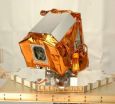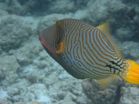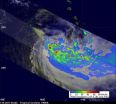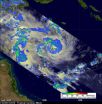(Press-News.org) A woman passing by the window display is captivated and asks her companion "Isn't the leather bag chic?" "Which one do you mean? There are so many of them." The woman points to one of the bags and as if by magic the luxurious purse appears on a display behind the shop window. Then she points to a button and the designer object rotates on the screen. "So that's what it looks like from the back." The woman passing by is impressed. She makes another gesture to zoom the bag towards her letting her to see every detail.
This particular shopping experience is courtesy of new type of 3-D camera system from the Fraunhofer Institute for Telecommunications, Heinrich Hertz Institute (HHI) in Berlin, Germany. Its interactive shop window enables people passing by to put goods behind shop windows onto a display with simple hand and facial gestures. Paul Chojecki is a scientist at the Fraunhofer Institute for Telecommunications, Heinrich Hertz Institute and he puts it this way: "Interactive shopping has been standard operating procedure in the web for a long time. Now, we're putting this technology into pedestrian passageways and shopping centers with the entire unit behind the window."
Four little cameras continually record the 3-D positions of the hands, faces and eyes of persons passing by. Then, image-processing software calculates the coordinates and transforms them into the corresponding inputs for selecting goods, viewing them in detail and immediately purchasing them – even after business hours. Anyone interested can have also themselves shown product information such as color, material, price, availability and information on the manufacturer. Paul Chojecki remarks that "there's nothing comparable in Germany yet and today shops only use touchscreens in shop windows, if at all. But, you can interact with our interactive shop window without any physical contact, which is a benefit if hygiene is important to you."
The interactive shop window consists of four cameras and visualization software. Two of these stereo cameras record the face and eyes while the other two record the motion of the hands. Image processing recognizes both gestures such as when you turn your hand and when you point to a button with your finger that you can see on a monitor. The researcher adds that "the system doesn't store any personal data and only the coordinates of the body parts it recognizes are passed onto the visualization."
Interactive shop window is compatible with all displays and the shop owner can select any monitor size or type of monitor from plasma, LED, LCD, projection or reprojection screens. Beyond this, shop owners can link the system with any software already there such as content management or merchandise information system enabling them to portray all of their stock of goods on the display. The way the payment process is taken care of is also left up to the shop owner. But that's not all. The interactive shop window not only identifies how many people are in front of the shop window, but it also can suggest on the basis of the gathered data what products and information the people passing by are interested in. Finally, it has customized greeting texts on the display to guarantee a close bond to the customer.
The interactive shop window was developed for use in shopping centers and the retail trade, although Chojecki thinks it would be possible to install it in museums or at trade fairs. This 3-D recording system is only a prototype at present, but the researchers will be demonstrating it at the CeBit Fair in Hannover, Germany Fraunhofer's joint stand (Hall 9, Stand B36) March 1 to 5, 2011.
INFORMATION:
Interactive window shopping
2011-01-15
ELSE PRESS RELEASES FROM THIS DATE:
Measles virus plays role in Paget's disease of bone, Pitt-led team says
2011-01-15
PITTSBURGH, Jan. 14 – A gene from the measles virus plays a key role in the development of Paget's disease of bone, according to a team of researchers led by the University of Pittsburgh School of Medicine. Their findings, recently published in Cell Metabolism, confirm a long-held speculation that the childhood infection is an environmental trigger for the disease and reveal how the viral gene contributes to the development of its characteristic bone lesions.
"Our earlier work showed that bone cells called osteoclasts in about 70 percent of these patients contain a certain ...
Learning while driving
2011-01-15
The days are long gone when all you needed to be a truck driver was a heavy goods vehicle license and the ability to read a map. Nowadays it is a skilled occupation which requires lots of qualifications. Modern truck drivers have to operate electronic devices, adapt their routes expertly to the given traffic and loading situation, know how to drive fuel-efficiently, be up to date with statutory regulations and monitor the safety of their load. Then there is all the complex legislation introduced at EU level. What's more, drivers who make trips to other countries also need ...
Enhanced early childhood education pays long-term dividends in better health
2011-01-15
January 14, 2011 -- Intensive early education programs for low-income children have been shown to yield numerous educational benefits, but few studies have looked more broadly at their impact on health and health behaviors. A new study conducted by researchers at Columbia University's Mailman School of Public Health examines this issue, using data from a the well-known Carolina Abecedarian Project (ABC), a randomized control study that enrolled 111 infants in the 1970s and continued to follow them through age 21. Researchers found that individuals who had received the ...
Improved measurements of sun to advance understanding of climate change
2011-01-15
WASHINGTON—Scientists have taken a major step toward accurately determining the amount of energy that the sun provides to Earth, and how variations in that energy may contribute to climate change.
In a new study of laboratory and satellite data, researchers report a lower value of that energy, known as total solar irradiance, than previously measured and demonstrate that the satellite instrument that made the measurement—which has a new optical design and was calibrated in a new way—has significantly improved the accuracy and consistency of such measurements.
The new ...
Researchers discover way to halt lung inflammation in animal models
2011-01-15
AURORA, Colo. (Jan. 14, 2011) - Acute inflammation of the lung is a poorly recognized human disease that develops in surprising and unexpected ways. The acute lung injury (ALI) or adult respiratory distress syndrome (ARDS) is a vital new concern for soldiers, but it can develop in anyone during a systemic infection, after severe trauma, as a result of bone fracture, following severe burns and in many other ways as well-- the initial cause may have nothing apparent to do with the lung itself. However, an answer to halting lung inflammation may have been discovered, thanks ...
Study finds fisheries management makes coral reefs grow faster
2011-01-15
An 18-year study of Kenya's coral reefs by the Wildlife Conservation Society and the University of California at Santa Cruz has found that overfished reef systems have more sea urchins—organisms that in turn eat coral algae that build tropical reef systems.
By contrast, reef systems closed to fishing have fewer sea urchins—the result of predatory fish keeping urchins under control—and higher coral growth rates and more structure.
The paper appears in the December 2010 issue of the scientific journal Ecology. The authors include Jennifer O'Leary of the University of ...
NASA's Aqua sees Tropical Storm Vince about to U-turn away from Australia
2011-01-15
Building high pressure is expected to make Tropical Storm Vince do a U-turn in the Southern Indian Ocean and take a westward track away from Western Australia. Two instruments on NASA's Aqua satellite looked at Vince's clouds this morning before Vince's forecast U-turn.
From its vantage point in space, Aqua passed over Tropical Storm Vince on January 14 at 06:20 UTC (1:20 a.m. EST/2:20 p.m. Australia/Perth time) and the Moderate Resolution Spectroradiometer (MODIS) instrument captured a visible image that showed the bulk of Vince's thunderstorms southwest of the storm's ...
NASA satellite: Tropical Storm Vania brought heavy rains to southeastern New Caledonia
2011-01-15
Tropical Storm Vania moved through southeastern New Caledonia on January 14 and NASA's TRMM satellite noticed heavy rainfall occurring. Residents of Norfolk Island are now expected to receive gusty winds and rainfall as Vania continues to move south in the South Pacific Ocean.
New Caledonia is located in the southwest Pacific and is made up of a main island called Grande Terre, the Loyalty Islands and several smaller islands.
At 0422 UTC (3:22 p.m. Pacific/Noumea local time) on January 14, the Tropical Rainfall Measuring Mission (TRMM) satellite, managed by NASA and ...
NASA's TRMM Satellite sees Zelia born of System 94P
2011-01-15
The low pressure area known as System 94P on January 13 strengthened into the seventh tropical cyclone of the South Pacific Cyclone season, today becoming Tropical Storm Zelia. NASA's TRMM satellite found heavy rainfall was already occurring in the storm as it was turning away from New Zealand and heading toward New Caledonia.
New Caledonia just dealt with Tropical Storm Vince today, and is expecting to feel winds and rains from Tropical Storm Zelia as it passes to the southwest of the island group this weekend.
The Tropical Rainfall Measuring Mission (TRMM) satellite, ...
Blood pressure control system found in kidney's structural units
2011-01-15
SAN ANTONIO (Jan. 14, 2010) — The kidney is made up of roughly 1 million working units called nephrons. These basic structural units remove waste products from the blood, recycle some substances to be reused and eliminate what is left as urine. The end segment of nephrons, called the distal nephron, helps set blood pressure by controlling the amount of sodium in our blood.
Today scientists at The University of Texas Health Science Center San Antonio reported how this essential function of the distal nephron is regulated. They demonstrated that sodium handling by the ...







